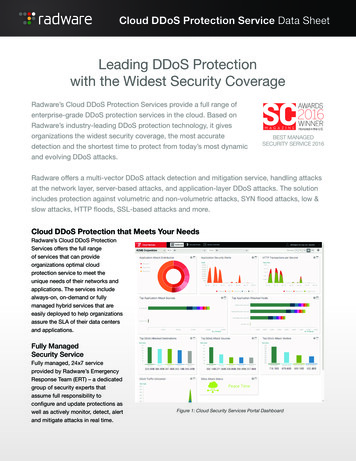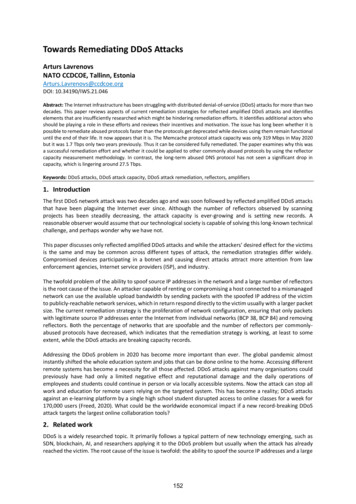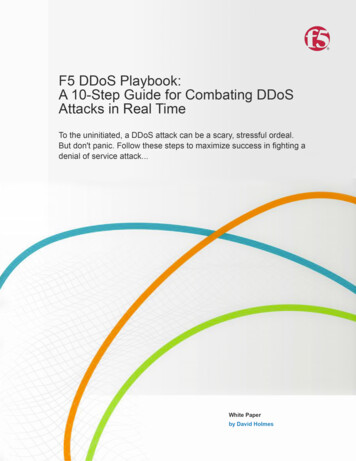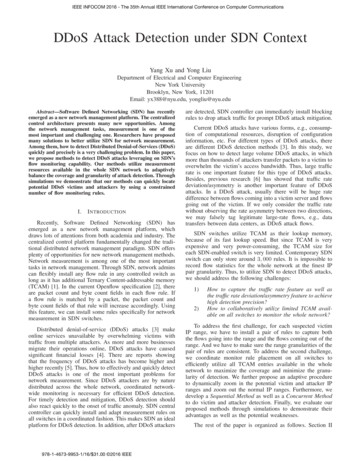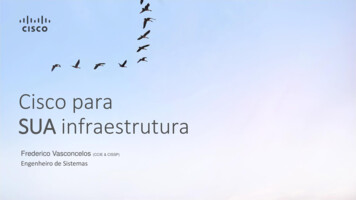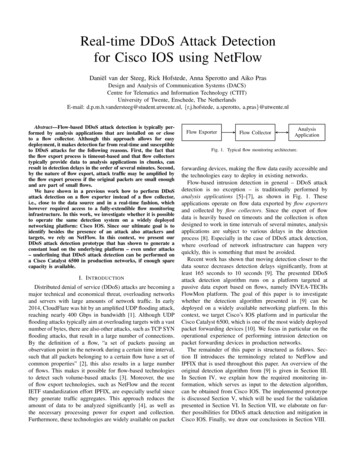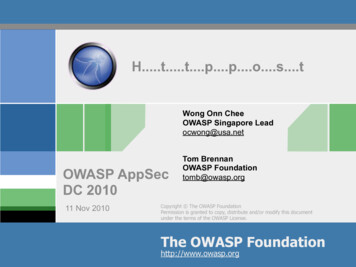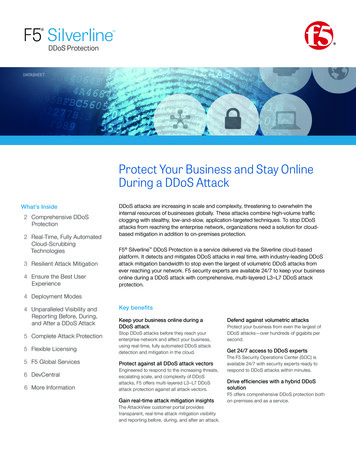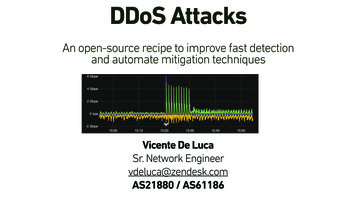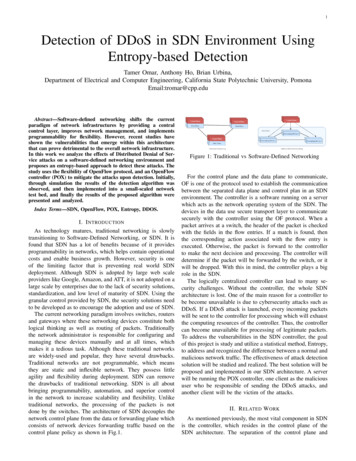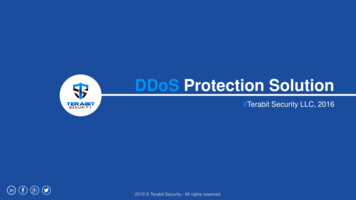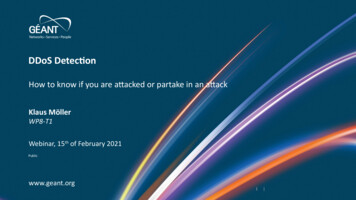
Transcription
Click to edit Master title style DDoSClick Detectionto edit Master text styles Second levelThird levelHow to knowif you are attacked or partake in an attack Fourth level Fifth levelKlaus MöllerWP8-T1Webinar, 15th of February 2021Publicwww.geant.org14/02/221 www.geant.org1
What we will cover today Introduction to the detection task Sensors used in DDoS detection–Short Introduction to NetFlows–Example of a detection system: NeMo Detection–Workflow–Structured Traffic Analysis Traffic Details–Control Server, Bots, D(R)DoS–Backscatter2 www.geant.org
Click to edit Master title style Click to edit Master text styles Second level Third levelIntroductionto Detection Fourth level Fifth levelwww.geant.org14/02/22 GÉANT Association on behalf of the GN4 Phase 2 project (GN4-2).The research leading to these results has received funding fromthe European Union’s Horizon 2020 research and innovationprogramme under Grant Agreement No. 731122 (GN4-2).3 www.geant.org3
DDoS Traffic Flow timDDoStrafficC&C trafficProxyC&C ServerBots4 www.geant.org
Challenges/Obstacles in DDoS Detection Sensor needs to be in path of the traffic type to be detectedDistinguishing malicious traffic (C&C, D(R)Dos) from legitimate– Reliable detection– Low false negative rateTimely– Low false positive rateNo use if too lateCritical foracceptanceand usability!Actionable–Results must allow mitigation or other useful action5 www.geant.org
Click to edit Master title style Click to edit Master text styles Second level Third levelSensors Fourth level Fifth levelwww.geant.org14/02/22 GÉANT Association on behalf of the GN4 Phase 2 project (GN4-2).The research leading to these results has received funding fromthe European Union’s Horizon 2020 research and innovationprogramme under Grant Agreement No. 731122 (GN4-2).6 www.geant.org6
Sensor Placement ISP: Ingress/egress points into network–– Victim network: Link(s) to ISP(s)– At least the most important ones (better all of them)Alternatively: Core links/routers (fewer sensors needed)Sometimes only link to vital on-premise serversPlacement dictated by available resources–––Processing power, bandwidth, memory, or bus-slots in routers/switchesRack space (mitigation needs a lot more)Ultimately a question of available budget7 www.geant.org
Sensor Types Packet sniffers – tcpdump, wireshark, etc.– Flow data – NetFlow, sFlow, Argus, AppFlow, NetStream, etc.– Reduced amount of data, but still usable for accounting and security purposesVarious values read from system or SNMP MIB– 1:1 copy of network packets, huge amounts of dataCPU load, bandwidth used, error rates, queue usage, etc.Miscellaneous data–––Routing tablesCustomer Relationship Management (CRM): contacts, billing, etc.Cabling, system location, hardware information, etc.8 www.geant.org
NetFlow Traffic is observed by probes at observation points (IPFIX)– Can be dedicated hardware probes, but often build into routers and switchesData from probes is aggregated by the exporter that sends flow records to acollector that stores the flow records data while the analysis applicationanalyzes the traffic in the context of intrusion detection, traffic profiling, etc.Protocol for the data exchange between exporter and collector has beenstandardized as NetFlow (RFC 3954)––Later standard that builds on NetFlow: IP Flow Information Export (IPFIX, RFC 7011/12)Storage format is not standardized (but conversion-tools nalysisApplicationStorage9 www.geant.org
(Net)Flow Records Flow: any number of packets observed in a specific time slot andsharing a number of properties–––––– Source & destination IP addressIP protocol number (e. g. ICMP, TCP, UDP, etc.)TCP/UDP/SCTP source & destination port numbers, or ICMP type & codeIP Type of Service (TOS)By definition: Flows are unidirectionalApplication data (layer 5 ) not part of the flow dataFlow record: the above information plus––Number of packets & bytes seen in the timeslotMore data: input/output interface, AS number, next hop address and more Depending on the NetFlow protocol version used10 www.geant.org
Sampled NetFlow Evaluating every packet consumes too many resources on high-speedlinks–––––– Sampling reduces number of packets taken into account: 1 out of nn: Sample Rate (typically 100 - 1.000.000)Result is called Sampled NetFlowStill accurate enough for a general traffic picture and DDoS detectionMore privacy protection friendly (except for n 1:)Might not detect small, short-lived flows at larger values of nDo not confuse with sFlow (Sampled Flow, RFC 3176)––Samples of counters(Random) samples of packets or application operations11 www.geant.org
NeMo - Network MonitoringSystem to detect and mitigate DDoS attacks in the German NREN (DFN)EmailCRM smdSNMPAlso a GÉANT 4-3 project: WP8, Task 3.3www.geant.org
NeMo - Alarm Analysis GUI13 www.geant.org
Click to edit Master title style Click to edit Master text styles Second level Third levelDetection Fourth level Fifth levelwww.geant.org14/02/22 GÉANT Association on behalf of the GN4 Phase 2 project (GN4-2).The research leading to these results has received funding fromthe European Union’s Horizon 2020 research and innovationprogramme under Grant Agreement No. 731122 (GN4-2).14 www.geant.org14
Detection Workflow – Base lining If you don’t know what’s normally going on in your network––– Even when outsourcing or automating (AI), an overview is needed– How will you ever know when something unusual happens?When things stop working/people complain?It’s too late to start base lining thenHow else will you know if you’re being ripped of or what the AI is learning?Know your network, esp. traffic distribution––––Most active source and destination IP addresses (“top talkers”)Network link utilizationTransport & application distributionTraffic changes over time – trends, recurrences (work hrs, holidays, )15 www.geant.org
Structured Traffic Analysis 1/4: Statistics Protocol hierarchy breakdown–IPv4/IPv6, TCP, UDP, HTTP, SSH, DNS, etc.–Gives a first idea with what to deal (e. g. ICMP flood, UDP flood) andwhich service (port number) is being attacked16 www.geant.org
Structured Traffic Analysis 2/4: Size(s) matter Packet size distribution–Many small packets possible sign of packet switching attack–Many large packets possible sign of bandwidth exhaustion attack17 www.geant.org
Structured Traffic Analysis 3/4 : Sessions (Flows) Look for sessions (flows)–Incoming vs. outgoing traffic–Top talkers (IP addresses) Known Good/Bad IP addresses–Partners/Customers–WoT, Shadowserver, MISP, etc.18 www.geant.org
Structured Traffic Analysis 4/4 : Full packet captures Sometimes needed–Easy to get with sFlow–Or via port mirroring of switches or dedicated probes at critical points–But need to set up sensors in advance Gives insight into–Application type of attacks Check samples against NIDS to look for exploits of vulnerabilities–Zeek (Bro), Suricata, Snort, Yara, etc. Don’t forget decryption for TLS or VPNs Check with your DPO (esp. with little/shaky evidence)19 www.geant.org
Click to edit Master title style Click to edit Master text styles Second level Third levelTrafficCharacteristics Fourth level Fifth levelwww.geant.org14/02/22 GÉANT Association on behalf of the GN4 Phase 2 project (GN4-2).The research leading to these results has received funding fromthe European Union’s Horizon 2020 research and innovationprogramme under Grant Agreement No. 731122 (GN4-2).20 www.geant.org20
DDoS Traffic Characteristics: C&C Server From Attacker (via Proxy) to C&C Server– From Bots to C&C server (cmd pull) or––– Traffic type may vary: HTTPS, VPN, or otherShort lived connections (usually just one HTTP GET request)Small amount of data transferred (bot cmd, bot config, sometimes code updates)Server IP address may co-host legitimate websitesFrom C&C server to Bots (cmd push)–Will need open port on the Bot –Or reverse connection Traffic may be piggybacked on top of other traffic (HTTP, DNS, etc.)Usually long-livedBottom line: too hard, don’t bother, unless you have a lead to follow21 www.geant.org
DDoS Traffic Characteristics: Bots vs. Clients Bots to Victim traffic–Source IP address: Spoofed (random) –When source addresses are filtered: subnet of the bot or the bot itselfLots of “empty” sessions: Low number of packets,Very little data transferred, small packets (unless flooding) Normal (high usage) traffic–Lower number of source IP-addresses ––Often known, like backup servers, customers, partners, etc.Sessions do actually transfer data - more symmetric traffic distributionIs there a reason? Backup time, “slashdotted/heise effect”, launch of service, ?22 www.geant.org
DDoS Traffic Characteristics: DRDoS Traffic Protocols:–– From Amplifiers/Reflectors to victim–– Usually ICMP or UDP - easy spoofingRarely TCP - needs application that can be triggeredSource address of amplifier is not spoofedOften that of known open amplifiers ( Shadowserver)From Bots to Amplifiers/Reflector–Bandwidth used usually not suspicious Small packetsBot distributes traffic across many amplifiers/reflectorsUnless sensor is placed in front of the reflector23 www.geant.org
DDoS Backscatter DDoS traffic may elicitresponses from victim–I.e. TCP SYN-ACK packets inresponse to TCP SYN (floods)–Or ICMP unreachable, orApplication responses, .– Amplifiers/ReflectorsTo random IP addresses ifbots spoof the source IPaddress––If not spoofed, directly backto the bots IP addressResponses to DRDoS trafficwill go to ficBotsC&C Server24 www.geant.org
DDoS Backscatter Detection - Network Telescope Technology used is the same as for other DDoS traffic–Sensors, collectors, analysers, etc. To distinguish from other traffic, look only for incoming traffic to unused(dark) IP addresses–“Darknet”, if interspersed with live addresses “Greynet”–Other names: “network motion sensors”, “network sink”, “blackhole monitor”–Best if IP address space was never used in production (very rare today)–Doesn’t need to be continuous–Amount of DDoS traffic seen by sensors would be proportional to the number of IPaddresses covered by sensors–Assuming perfectly random distribution with spoofed IP addresses25 www.geant.org
DDoS Backscatter Detection - Traffic Patterns Source IP address is that of the victimRandom destination IP addresses, no coherenceSource port that of the attacked service– Destination ports random, usually ephemeral ports ( 1023)– May see some “ladder” if DDoS tool uses changing port numbersLayer 5 contents depend on type of DDoS– Usually port 80/tcp or 443/tcpWill not be present in flow data - full packet captures neededTraffic may be from multiple DDoS techniques as attackersemploy them at once against a target26 www.geant.org
Click to edit Master title style Click to edit Master text styles Second level Third levelDetectionSystems Fourth level Fifth levelwww.geant.org14/02/22 GÉANT Association on behalf of the GN4 Phase 2 project (GN4-2).The research leading to these results has received funding fromthe European Union’s Horizon 2020 research and innovationprogramme under Grant Agreement No. 731122 (GN4-2).27 www.geant.org27
What have you learned? Analysis looks easy––– Not to stall optimism, BUT–––– Have some nice toolsStructured approachI can do that:)Examples shown are labs/low usage networksAnalysis on busy production networks is much harderMost of today's DDoS attacks are using more than one vectorAttackers adapt to countermeasures i.e. change tactics & techniquesPractice, practice, practice, And then you need to mitigate the attack next session28 www.geant.org
Click to edit Master title style Click to edit Master text styles Second level Third levelThankyou Fourth levelAny questions? Fifth levelNext course: DDoS Mitigation17th of February 2021www.geant.org14/02/22 GÉANT Association on behalf of the GN4 Phase 2 project (GN4-2).The research leading to these results has received funding fromthe European Union’s Horizon 2020 research and innovationprogramme under Grant Agreement No. 731122 (GN4-2).29 www.geant.org29
References: M. Collins: “Network Security Through Data Analysis – Building Situational Awareness”,O’Reilly, February 2014: ISBN:978-1-449-35790-0M. Collins: “Network Security Through Data Analysis – From Data to Action”, 2nd Ed. ,O’Reilly, October 2017, ISBN: 978-1491962848R. Bejtlich: “Tao of Network Security Monitoring, The: Beyond Intrusion Detection”,Addison Wesley, July 2004, ISBN-13: 978-0321246776R. Bejtlich: “The Practice of Network Security Monitoring: Understanding IncidentDetection and Response”, NoStarch Press, July 2013, ISBN-13: 978-1593275099M. W. Lucas: “Network Flow Analysis”, NoStarch Press, 2010, ISBN-13: 978-1-59327203-6Joseph O’Hara: “Cloud-based network telescope for Internet background radiationcollection”, University of Dublin, Trinity College, April 2019/TCD-SCSSDISSERTATION-2019-020.pdf Shadowserver Foundation: https://www.shadowserver.org/30 www.geant.org
NetFlow Tools Pmacct: https://github.com/pmacct/pmacct/NFStream: https://www.nfstream.org/argus: lowd: https://github.com/irino/softflowdSLiK Suite:– FlowViewer GUI for SILK tools:Nfdump: https://github.com/phaag/nfdumpNfsen-ng: https://github.com/mbolli/nfsen-ngGoFlow: https://github.com/cloudflare/goflow– Dynamite NSM: https://dynamite.ai/dynamitensm/– /github.com/DynamiteAI/dynamite-nsmSecurity Onion: https://securityonionsolutions.com/31 www.geant.org
RFCs P. Phaal, RFC 3176: “InMon Corporation's sFlow: A Method forMonitoring Traffic in Switched and Routed Networks “, September2001, https://tools.ietf.org/html/rfc3176B. Claise, Ed., RFC 3954: “Cisco Systems NetFlow Services ExportVersion 9”, October 2004, https://tools.ietf.org/html/rfc3954B. Claise, Ed., RFC 7011: “Specification of the IP Flow InformationExport (IPFIX) Protocol for the Exchange of Flow Information”,September 2013, https://tools.ietf.org/html/rfc7011B. Claise, Ed., RFC 7012: “Information Model for IP Flow InformationExport (IPFIX)”, September 2013,https://tools.ietf.org/html/rfc701232 www.geant.org
9 www.geant.org NetFlow Traffic is observed by probes at observation points (IPFIX) - Can be dedicated hardware probes, but often build into routers and switches Data from probes is aggregated by the exporter that sends flow records to a collector that stores the flow records data while the analysis application analyzes the traffic in the context of intrusion detection, traffic profiling, etc.
